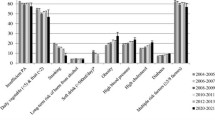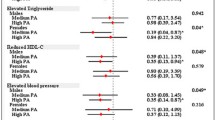Abstract
Objective
To highlight the value of continuous risk factor surveillance systems in providing evidence of the impact of, and to inform health promotion interventions.
Method
An ongoing risk factor surveillance system involving telephone interviews with approximately n = 600 randomly selected South Australians each month. Trend analysis on physical activity (PA) levels and daily consumption of fruit and vegetables was undertaken.
Results
An apparent seasonal trend for fruit consumption and PA was found, with less activity and fruit consumption undertaken in winter months. Overweight/obese adults exercised less than those with normal BMI, and females less than males, although PA rates for both females and overweight/obese adults are rising. There was an increase in vegetable consumption following a major media campaign. Although reported prevalence of the consumption of five or more serves of vegetables daily and the mean number of serves consumed daily has decreased, it is still above pre-campaign rates.
Conclusion
Additional information obtained from a risk factor surveillance system, when compared to an annual or point-in-time survey, provides valuable evidence for health professionals interested in measuring and assessing the effectiveness of health promotion interventions.




Similar content being viewed by others
References
Adams T, Lin V (1998) Partnership in public health. World Health Forum 19:246–252
Armstrong T, Bauman A, Davies J (2000) Physical activity patterns of Australian adults. Australian Institute of Health and Welfare, Canberra
Australian Bureau of Statistics (2004) Population by age and sex, South Australia. 2004. Cat 3235.4.55.001. Australian Bureau of Statistics, Canberra
Campostrini S (2007) Measurement and effectiveness: methodological considerations, issues and possible solutions. In: McQueen D, Jones C (eds) Global perspectives on health promotion effectiveness. Springer, New York, pp 305–325
Campostrini S, Holtzman D, McQueen DV, Boaretto E (2006) Evaluating the effectiveness of health promotion policy: changes in the law on drinking and driving in California. Health Promot Int 21:130–135
Chambers LW, Ehrlich A, Picard D, Edwards P (2002) The art and science of evidence-based decision-making: epidemiology can help!. Can J Public Health 93:I1–I8
Commonwealth Department of Health and Family Services (1998) The Australian guide to healthy eating. Commonwealth of Australia, Canberra. http://www.health.gov.au/internet/wcms/Publishing.nsf/Content/health-pubhlth-publicat-document-fdeduc-cnt.htm/$FILE/fdeduc.pdf
de Bruin A, Picavet HS, Nossikov A (1996) Health interview surveys. Towards international harmonization of methods and instruments. WHO Reg Publ Eur Ser 58. WHO, Copenhagen
Dean K (1993) Integrating theory and methods in population health research. In: Dean K (ed) Linking theory and methods. SAGE, London, pp 9–36
Doyle J, Waters E, Yach D, McQueen D et al (2005) Global priority setting for Cochrane systematic reviews of health promotion and public health research. J Epidemiol Community Health 59:193–197
Durch JS, Bailey LA, Stoto MA (1997) Improving health in the community. A role for performance monitoring. National Academy Press, Washington
Harris E, Sainsbury P (2002) Tackling health inequalities: balancing universal and targeted approaches. NSW Public Health Bull 13(3):33–35
National Health and Medical Research Council (2003) Dietary guidelines for Australian Adults. Commonwealth of Australia, Canberra
Holtzman D (2003) Analysis and interpretation of data from the US behavioural risk factor surveillance system (BRFSS). In: McQueen D, Puska P (eds) Global behavioural risk factor surveillance. Kluwer/Plenum Publishers, New York
Keleher H, MacDougal C, Murphy B (2007) Approaching health promotion. In: Keleher H, MacDougall C, Murphy B (eds) Understanding health promotion. Oxford University Press, Melbourne
Legault D, Mowat D, Tate B, White M et al (2000) Sharing health surveillance information using the National Health Surveillance Infostructure. http://itch.uvic.ca/itch2000/LEGAULT/LEGAULT.HTM 15/05/2002
Lopez AD (2003) Evidence and information for health policy: a decade of change. Med J Aust 179:396–397
McQueen DV (2000) Strengthening the evidence base for health promotion. In: Fifth global conference on health promotion, Mexico City, Mexico
McQueen DV, Puska P (2003) Global behavioral risk factor surveillance. Kluwer, New York
Mostashari F, Kerker BD, Hajat A, Miller N, Frieden TR (2005) Smoking practices in New York City: the use of a population-based survey to guide policy-making and programming. J Urban Health 82:58–70
Nutbeam D, Bauman A (2006) Evaluation in a nutshell: a practical guide to the evaluation of health promotion programs. Mc-Graw Hill, Australia
Population Research and Outcome Studies Unit (2002) The South Australian Monitoring and Surveillance System (SAMSS) 2002-20: brief report. South Australian Department of Health, Adelaide. http://www.health.sa.gov.au/pros/portals/0/BR%202002-20%20SAMSS.pdf
Remington PL, Smith MY, Williamson DF, Anda RF, Gentry EM, Hogelin GC (1988) Design, characteristics, and usefulness of state-based behavioral risk factor surveillance: 1981–87. Public Health Rep 103(4):366–375
Ruffin M Jr (2000) Building a framework to transform health care. Physician Exec 26:46–50
Rychetnik L, Hawe P, Waters E, Barrett A, Frommer M (2004) A glossary for evidence based public health. J Epidemiol Community Health 58:538–545
Tang KC, Ehsani JP, McQueen DV (2003) Evidence based health promotion: recollections, reflections, and reconsiderations. J Epidemiol Community Health 57:841–843
Wang S, Moss JR, Hiller JE (2005) Applicability and transferability of interventions in evidence-based public health. Health Promot In 21(1):76–83
World Health Organization (2000) Obesity: preventing and managing the global epidemic. World Health Organization, Geneva
World Health Organization (2005) Part three—what works: the evidence for action. In: Preventing chronic diseases: a vital investment. WHO Global Report
Author information
Authors and Affiliations
Corresponding author
Rights and permissions
About this article
Cite this article
Taylor, A.W., Campostrini, S., Gill, T.K. et al. The use of chronic disease risk factor surveillance systems for evidence-based decision-making: physical activity and nutrition as examples. Int J Public Health 55, 243–249 (2010). https://doi.org/10.1007/s00038-009-0098-7
Received:
Revised:
Accepted:
Published:
Issue Date:
DOI: https://doi.org/10.1007/s00038-009-0098-7




